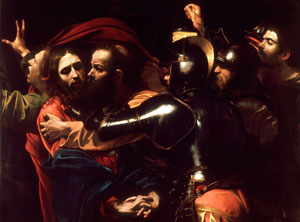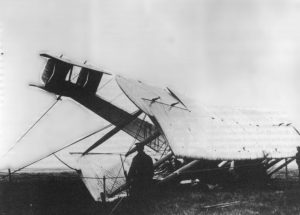June 15
Published in On this Day listing- 1920 RIC District Inspector Percival Lea-Wilson was shot dead by the IRA in Gorey, Co. Wexford.
- 1919 Captain John Alcock and Lt. Arthur Brown completed the first transatlantic flight when their Vickers Vimy biplane landed near Clifden, Co. Galway, after a 2,500km flight from St John’s, Newfoundland.
- 1920

Above: Caravaggio’s The Taking of Christ, c. 1602. (NGI)
Percival Lee-Wilson (33), RIC district inspector for North Wexford, a marked man because of his brutal treatment of Tom Clarke after the surrender in Easter 1916, was assassinated by the IRA in Gorey. The sudden death of Lee-Wilson, or rather its effect on his young widow, Galway-born Marie Ryan, whom he married in 1914, was a key factor in one of the greatest art discoveries of the twentieth century. In late 1990 Sergio Benedetti, a conservator at the National Gallery of Ireland, was invited to a Jesuit community house in Leeson Street to look over their collection of paintings—all quite routine until he came to The Taking of Christ, attributed to the Dutch painter Gerrit van Honthorst. Benedetti was startled. As a specialist in Caravaggio and his followers, he was convinced that he was looking not at a Honthorst—he painted in the same style—but at Caravaggio’s long-lost original, which he painted in 1602 for his patrons in Rome, the Mattei family. What followed was three years of historical detective work. Working through the Mattei archives, two Italian Ph.D students traced its history from commission to payment to the year 1793, when a careless archivist misattributed it to Honthorst. Ten years after that it was sold—as a Honthorst—along with other paintings to a Scottish landowner, and a century later, having ironically been turned down by the Scottish National Gallery, to an Edinburgh art dealer who sold it, in 1921, to an unknown buyer for the princely sum of £8-8-0d. That buyer was Lee-Wilson’s widow, who qualified as a paediatrician in 1928. A devout Catholic, she had gifted the painting to the Jesuits for their support after her husband’s death. She died in 1971.
- 1996 A 3,500lb. IRA bomb, the largest in Britain since the Second World War, devastated the centre of Manchester; 200 people were injured and damage was estimated at over £300m.
- 1988 Six British soldiers were killed by an IRA bomb after taking part in a ‘fun run’ in Lisburn, Co. Antrim.
- 1861 Fred Allan, leading figure in the IRB during the Parnell era, founder member of Cumann na nGaedhael and civil servant with the Department of Industry and Commerce, who played a significant role in the setting up of the Shannon Electricity Supply Scheme, born in Dublin.
- 1815 Howard Egan, sailor, policeman, personal bodyguard to Mormon founder John Smith and divisional superintendent with the Pony Express (established 150 years ago in April 1860), born in Tullamore, Co. Offaly.
-

Above: The crashed Vickers Vimy biplane piloted by John Alcock and Arthur Brown in Derrygimla bog, near Clifton, Co. Galway.
1919 John Alcock and Arthur Brown, in a Vickers Vimy biplane, crash-landed beside the Marconi wireless station in Derrygimla bog near Clifton, Co. Galway, to complete the first non-stop transatlantic flight. Taking off from Newfoundland, they were assisted by favourable winds, sustaining themselves throughout with sandwiches and chocolate washed down with copious amounts of beer and coffee, to complete the 1,900-mile journey in sixteen hours and twelve minutes and claim the £10,000 prize offered by the Daily Mail for a crossing in ‘less than 72 consecutive hours’. It was a big day for the former RAF pilots, who were knighted a few days later by King George. It was a big day, too, for Tom ‘Cork’ Kenny, proprietor of the Connaught Telegraph. He famously got to the bog before the man from the Daily Mail, conducted the first interview with the pair and sold his scoop all over the world. His previous big story had featured the deaths of two RIC officers during the rescue of Seán Hogan by Dan Breen and Seán Treacy at Knocklong railway station, Co. Limerick, some weeks earlier. Both Alcock and Brown died prematurely. In the days when the life expectancy of even a peacetime flier was a mere four years, Alcock, aged 27, was killed just six months later when his plane struck a tree near Rouen in France. Brown went on to work in the burgeoning aircraft industry but never got over the loss in an air crash of his only son while serving with the RAF in June 1944. He died in 1948, aged 62, from an overdose of barbiturates.
- 1988 Six British soldiers were killed by an IRA bomb under their unmarked van in Lisburn, Co. Antrim. They had just taken part in a fun run for charity.
















